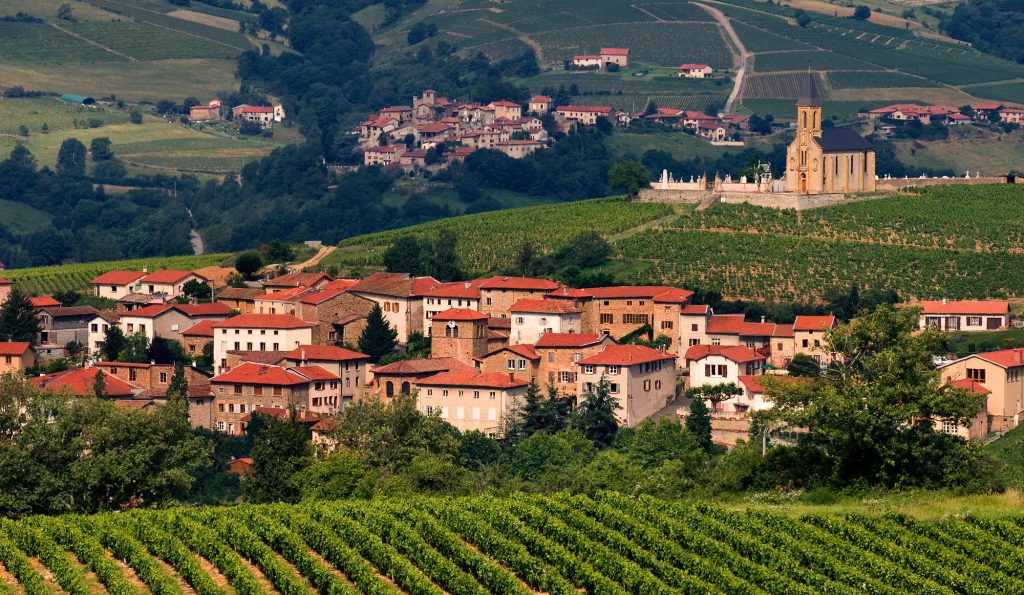Beaujolais is sort of a secret. It’s not a name that rolls off the tongue and unless you frequent Parisian bistros, you may never run into a cool, refreshing glass of this wonderful French wine. You might say Beaujolais is a wine encountered off the beaten track; a wine esteemed by the cognoscenti and unseen by the masses. But wait – what is Beaujolais anyway? Here’s the scoop on this celebrated red wine!
Beaujolais – pronounced “BO-zho-lay” – is the moniker for both a beautiful region of France and an ineffable red wine. Crafted from the black gamay grape, the wine originates from the region of Beaujolais in the southernmost tip of France’s Burgundy region. Historic records trace the origins of the gamay grape back to 14th century France when it grew prolifically across the center of the country.

Today, French wine production from the gamay grape is limited to Beaujolais. They don’t make it anywhere else! It is said, “All Beaujolais is Burgundy but not all Burgundy is Beaujolais.” True! With the rest of France’s famed Burgundy dedicated to the cultivation of primarily pinot noir and chardonnay, the wines of Beaujolais are distinctive and unique.
Beaujolais wines are divided into four categories. The first is Beaujolais AOC wines, which are crafted from grapes grown anywhere on the limestone and clay soils of Beaujolais. The second incorporates the wines of Beaujolais-Villages, which are considered a step up in terms of quality, and made only from grapes produced from the specific village named on the label. The third comprises the higher-end wines called the Beaujolais Crus. These come from the northern end of Beaujolais where the soils are primarily granitic. The Crus are the most distinguishing wines of Beaujolais. Each of the 10 Cru villages produces their own memorable take on Beaujolais. Some favorites include the romantically named “St. Amour”, “Fleurie”, and “Julienas’, named for Roman Emperor, Julius Caesar.
The final category is the most well-known. Beaujolais became world famous with the commercial launch of what’s called “Beaujolais Nouveau” – pronounced “BO-zho-lay noo-VOE”. Beaujolais Nouveau is a wine made from the first grapes of the harvest. Every third Thursday of November at 12:01 am, these fresh new wines arrive on the market and celebrations all over France and the world at large are uncorked. Prominent wine importer, Kermit Lynch, referred to the phenomenon of Beaujolais Nouveau as “downing a newborn wine that has barely left the grape.” His words ring true as the grapes are picked, crushed, fermented, and thrown into bottles in a matter of mere weeks. A newborn wine, indeed.

The tasting profile of a Beaujolais Nouveau is one of a kind. It might offer an interesting bouquet of bananas and bubblegum on the nose and a mouthful of juicy raspberries on the palate. No other Beaujolais wine has such unusual aromas (which could possibly be attributable to the specific yeast used during fermentation). Beaujolais Nouveau is made to be enjoyed immediately. A fragile young wine, it must be consumed within a few months of its production and will not age.
While the worldwide Beaujolais Nouveau merriment has always drawn excitement and curiosity, after the last of the revelers have gone home, those who appreciate the fine nuances of good Beaujolais remain dedicated and true. Classic Beaujolais has aromas and flavors of fresh cranberries and raspberries with crisp acid, low to medium tannins, and a vibrant minerality. The mouthwatering finish will stay on your mind long after the bottle is empty. A natural with casual foods like cold cuts, sandwiches, burgers and even hot dogs, Beaujolais is considered the ultimate picnic wine. Best served lightly chilled, nothing is more refreshing on a warm day than a tangy, dry glass of Beaujolais.
The best news is that Beaujolais is an extremely affordable wine. Top of the line Beaujolais Crus are an absolute bargain compared to the extreme prices of the other wines of Burgundy. You can get a good quality Beaujolais from $12 and the most expensive bottle rarely tops $35. Beaujolais is easily found online or in your favorite wine shop. Try it today. If in doubt, choose Beaujolais! Here’s to a fabulous summer!
Cheers!
Leave a Reply